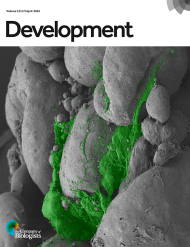Intestinal peroxisomal fatty acid β-oxidation regulates neural serotonin signaling through a feedback mechanism
Posted on: 29 May 2019
Preprint posted on 8 April 2019
Article now published in PLOS Biology at http://dx.doi.org/10.1371/journal.pbio.3000242
The Hunger Games: Peroxisomes are the central metabolic hubs that integrate metabolic status with the serotonergic signaling of feeding behaviour and fat metabolism
Selected by Pablo Ranea RoblesCategories: animal behavior and cognition, neuroscience, physiology
It is lunch time and, involuntarily, you start feeling hungry and initiate the search for food. The opposite happens after a meal, when you feel satiated and do not feel the need for seeking food. This appetite control mechanism is common in the animal kingdom and is regulated by neural pathways that adjust metabolic status to energy intake. Different sensors “speak” to the central nervous system about nutrient abundance in the organism, which initiate or repress signals that lead to food intake. These pathways of appetite control are impaired in obesity and related diseases, but despite the high prevalence of these diseases, the molecular basis of feeding circuits is not completely understood.
One of the main pathways that regulates feeding is serotonergic signaling, which also regulates fat metabolism. Fats constitute one of the main energy storage for animals, but their use needs to be tightly controlled in order to sustain homeostasis. Under nutrient scarcity, feeding behaviour is promoted, and fats are mobilized from internal stores as free fatty acids, activated to acyl-CoA molecules, and transported to mitochondria and peroxisomes for obtaining ATP by beta-oxidation. This metabolic process consumes large amounts of oxygen, so oxygen availability has to be monitored to allow fats to be mobilized. As beautifully exemplified by Niels Ringstad (Ringstad 2016), think of a gasoline engine that delivers fuel and oxygen to a piston in order to generate force. When the ratio of fuel (representing fat) to oxygen changes, the efficiency of the engine is affected. This is solved by engineers with oxygen and fuel sensors that allow to adjust the mix. Nature has its own sensor system to fine tune behavioural responses with metabolic status and environmental stimuli. However, there are still many questions about how such integration mechanistically happens. One good model to study this neurometabolic pathway is the nematode C. elegans, in which oxygen-sensing neurons were discovered. These neurons, called URX neurons, couple oxygen-sensing to the metabolic use of fat stores (Witham et al. 2016). However, the metabolic pathways and the nutrient cues involved in this metabolic sensor remain largely undefined.
Results
Bouagnon et al. identified in this preprint the components of a circuit that integrates peripheral nutrient cues to serotonin-regulated fat metabolism and feeding behaviour in the nematode C. elegans (Bouagnon et al. 2019). Based on previous findings that showed that fatty acid oxidation links serotonin control of fat metabolism and feeding behaviour (Srinivasan et al. 2008), they found that intestinal peroxisomal beta-oxidation regulates serotonin signaling. Animals defective for acyl-CoA oxidase 1 (Acox1), an enzyme of the peroxisomal beta-oxidation pathway, do not show the positive effect of serotonin on feeding and egg-laying behaviors. When serotonin is added to wild type nematodes, the pharyngeal pump activity and the egg-laying rate increase, but this response was blunted in acox-1 mutant animals. To better understand the molecular mechanism underlying this phenotype, they performed transcriptomic and metabolomic studies on these animals, and found more alterations in the metabolome than in the transcriptome. Even though they could not find the exact metabolite that would be causing this alteration in serotonergic signaling, they pointed to some accumulated metabolites, such as N-acylethanolamines (from the endocannabinoid family) and ascarosides, as potential candidates for causal agents.
They also identified the cellular component of this metabolic/neural pathway. Ether-a-go-go (EAG) potassium channels in body cavity neurons (such as URX neurons) were the key cellular components of this circuit. These potassium channels modulate the excitability of neuromuscular circuits in response to nutrient scarcity, which suggest that they link internal nutritional cues and neuronal activity. RNAi of egl-2, one of these potassium channels, rescued pharyngeal pumping rate and egg-laying phenotype in worms, whereas a gain-of-function mutant of egl-2 was sufficient to mimic acox-1 mutant phenotype in terms of serotonin-induced feeding behaviour and the egg-laying defect.
What I liked about the study
I liked this study because they found new players in the functional connection between feeding behaviour and lipid metabolism control, and they define exciting questions in this field that need to be explored. They also proved the utility of C. elegans as a model for neurometabolic research, and report a novel role of peroxisomal metabolism in feeding behaviour regulation, which expands the myriad of functions that peroxisomes carry out. Some of the big questions now are the metabolites involved in this neurometabolic pathway and whether this mechanism is conserved in mammals.
Open questions:
- Oleic acid represses feeding behaviour in worms. Is this mediated by peroxisomal metabolism? What would happen if oleic acid is added to acox-1 mutants in terms of serotonin-regulated feeding behaviour?
- Fasting recovered the effect of serotonin on feeding in acox-1 mutants. That means that acox-1 is not needed for this serotonin circuit in fasting conditions. Does it mean that lipid oxidation in mitochondria is enough for the signaling of this circuit? Or that other peroxisomal enzymes are induced and then overcome acox-1 function?
- In C. elegans, URX neurons couple the sensing of oxygen levels to feeding behaviour and fat metabolism. Is the identity of this neural pathway known in mammals?
References
Bouagnon, Aude, Shubhi Srivastava, Oishika Panda, Frank C. Schroeder, Supriya Srinivasan, and Kaveh Ashrafi. 2019. “Intestinal Peroxisomal Fatty Acid β-Oxidation Regulates Neural Serotonin Signaling through a Feedback Mechanism.” BioRxiv, April, 602649. https://doi.org/10.1101/602649.
Ringstad, Niels. 2016. “A Controlled Burn: Sensing Oxygen to Tune Fat Metabolism.” Cell Reports 14 (7): 1569–70. https://doi.org/10.1016/j.celrep.2016.02.015.
Srinivasan, Supriya, Leila Sadegh, Ida C. Elle, Anne G.L. Christensen, Nils J. Faergeman, and Kaveh Ashrafi. 2008. “Serotonin Regulates C. Elegans Fat and Feeding through Independent Molecular Mechanisms.” Cell Metabolism 7 (6): 533–44. https://doi.org/10.1016/j.cmet.2008.04.012.
Witham, Emily, Claudio Comunian, Harkaranveer Ratanpal, Susanne Skora, Manuel Zimmer, and Supriya Srinivasan. 2016. “C. Elegans Body Cavity Neurons Are Homeostatic Sensors That Integrate Fluctuations in Oxygen Availability and Internal Nutrient Reserves.” Cell Reports 14 (7): 1641–54. https://doi.org/10.1016/j.celrep.2016.01.052.
doi: https://doi.org/10.1242/prelights.10998
Read preprintSign up to customise the site to your preferences and to receive alerts
Register hereAlso in the animal behavior and cognition category:
Responses to conflicting binocular stimuli in mouse primary visual cortex
Maitri Manjunath
Effects of transcranial photobiomodulation on peripheral biomarkers associated with oxidative stress and complex IV activity in the prefrontal cortex in rats subjected to chronic mild stress
Rickson Ribeiro, Marcus Oliveira
Psychedelics Align Brain Activity with Context
Loïk Holdrinet et al.
Also in the neuroscience category:
Imaging cellular activity simultaneously across all organs of a vertebrate reveals body-wide circuits
Muhammed Sinan Malik
Post-translational Tuning of Human Cortical Progenitor Neuronal Output
Jawdat Sandakly
Maturation of the glymphatic system confers innate resistance of the brain to Zika virus infection
Jimeng Li
Also in the physiology category:
Imaging cellular activity simultaneously across all organs of a vertebrate reveals body-wide circuits
Muhammed Sinan Malik
Wide-ranging behavioral dysfunction in two mouse models of pathological human variants in the GRIK2 kainate receptor gene
Pushpinder Singh
Fibroblast growth factor 21 regulates neuromuscular junction innervation through HDAC4 in denervation-induced skeletal muscle atrophy
Jórdan Sampar
preLists in the animal behavior and cognition category:
Biologists @ 100 conference preList
This preList aims to capture all preprints being discussed at the Biologists @100 conference in Liverpool, UK, either as part of the poster sessions or the (flash/short/full-length) talks.
| List by | Reinier Prosee, Jonathan Townson |
9th International Symposium on the Biology of Vertebrate Sex Determination
This preList contains preprints discussed during the 9th International Symposium on the Biology of Vertebrate Sex Determination. This conference was held in Kona, Hawaii from April 17th to 21st 2023.
| List by | Martin Estermann |
Bats
A list of preprints dealing with the ecology, evolution and behavior of bats
| List by | Baheerathan Murugavel |
FENS 2020
A collection of preprints presented during the virtual meeting of the Federation of European Neuroscience Societies (FENS) in 2020
| List by | Ana Dorrego-Rivas |
Also in the neuroscience category:
November in preprints – DevBio & Stem cell biology
preLighters with expertise across developmental and stem cell biology have nominated a few developmental and stem cell biology (and related) preprints posted in November they’re excited about and explain in a single paragraph why. Concise preprint highlights, prepared by the preLighter community – a quick way to spot upcoming trends, new methods and fresh ideas.
| List by | Aline Grata et al. |
October in preprints – DevBio & Stem cell biology
Each month, preLighters with expertise across developmental and stem cell biology nominate a few recent developmental and stem cell biology (and related) preprints they’re excited about and explain in a single paragraph why. Short, snappy picks from working scientists — a quick way to spot fresh ideas, bold methods and papers worth reading in full. These preprints can all be found in the October preprint list published on the Node.
| List by | Deevitha Balasubramanian et al. |
October in preprints – Cell biology edition
Different preLighters, with expertise across cell biology, have worked together to create this preprint reading list for researchers with an interest in cell biology. This month, most picks fall under (1) Cell organelles and organisation, followed by (2) Mechanosignaling and mechanotransduction, (3) Cell cycle and division and (4) Cell migration
| List by | Matthew Davies et al. |
July in preprints – the CellBio edition
A group of preLighters, with expertise in different areas of cell biology, have worked together to create this preprint reading lists for researchers with an interest in cell biology. This month, categories include: (1) Cell Signalling and Mechanosensing (2) Cell Cycle and Division (3) Cell Migration and Cytoskeleton (4) Cancer Biology (5) Cell Organelles and Organisation
| List by | Girish Kale et al. |
May in preprints – the CellBio edition
A group of preLighters, with expertise in different areas of cell biology, have worked together to create this preprint reading lists for researchers with an interest in cell biology. This month, categories include: 1) Biochemistry/metabolism 2) Cancer cell Biology 3) Cell adhesion, migration and cytoskeleton 4) Cell organelles and organisation 5) Cell signalling and 6) Genetics
| List by | Barbora Knotkova et al. |
April in preprints – the CellBio edition
A group of preLighters, with expertise in different areas of cell biology, have worked together to create this preprint reading lists for researchers with an interest in cell biology. This month, categories include: 1) biochemistry/metabolism 2) cell cycle and division 3) cell organelles and organisation 4) cell signalling and mechanosensing 5) (epi)genetics
| List by | Vibha SINGH et al. |
Biologists @ 100 conference preList
This preList aims to capture all preprints being discussed at the Biologists @100 conference in Liverpool, UK, either as part of the poster sessions or the (flash/short/full-length) talks.
| List by | Reinier Prosee, Jonathan Townson |
2024 Hypothalamus GRC
This 2024 Hypothalamus GRC (Gordon Research Conference) preList offers an overview of cutting-edge research focused on the hypothalamus, a critical brain region involved in regulating homeostasis, behavior, and neuroendocrine functions. The studies included cover a range of topics, including neural circuits, molecular mechanisms, and the role of the hypothalamus in health and disease. This collection highlights some of the latest advances in understanding hypothalamic function, with potential implications for treating disorders such as obesity, stress, and metabolic diseases.
| List by | Nathalie Krauth |
‘In preprints’ from Development 2022-2023
A list of the preprints featured in Development's 'In preprints' articles between 2022-2023
| List by | Alex Eve, Katherine Brown |
CSHL 87th Symposium: Stem Cells
Preprints mentioned by speakers at the #CSHLsymp23
| List by | Alex Eve |
Journal of Cell Science meeting ‘Imaging Cell Dynamics’
This preList highlights the preprints discussed at the JCS meeting 'Imaging Cell Dynamics'. The meeting was held from 14 - 17 May 2023 in Lisbon, Portugal and was organised by Erika Holzbaur, Jennifer Lippincott-Schwartz, Rob Parton and Michael Way.
| List by | Helen Zenner |
ASCB EMBO Annual Meeting 2019
A collection of preprints presented at the 2019 ASCB EMBO Meeting in Washington, DC (December 7-11)
| List by | Madhuja Samaddar et al. |
SDB 78th Annual Meeting 2019
A curation of the preprints presented at the SDB meeting in Boston, July 26-30 2019. The preList will be updated throughout the duration of the meeting.
| List by | Alex Eve |
Autophagy
Preprints on autophagy and lysosomal degradation and its role in neurodegeneration and disease. Includes molecular mechanisms, upstream signalling and regulation as well as studies on pharmaceutical interventions to upregulate the process.
| List by | Sandra Malmgren Hill |
Young Embryologist Network Conference 2019
Preprints presented at the Young Embryologist Network 2019 conference, 13 May, The Francis Crick Institute, London
| List by | Alex Eve |
Also in the physiology category:
October in preprints – DevBio & Stem cell biology
Each month, preLighters with expertise across developmental and stem cell biology nominate a few recent developmental and stem cell biology (and related) preprints they’re excited about and explain in a single paragraph why. Short, snappy picks from working scientists — a quick way to spot fresh ideas, bold methods and papers worth reading in full. These preprints can all be found in the October preprint list published on the Node.
| List by | Deevitha Balasubramanian et al. |
Biologists @ 100 conference preList
This preList aims to capture all preprints being discussed at the Biologists @100 conference in Liverpool, UK, either as part of the poster sessions or the (flash/short/full-length) talks.
| List by | Reinier Prosee, Jonathan Townson |
Fibroblasts
The advances in fibroblast biology preList explores the recent discoveries and preprints of the fibroblast world. Get ready to immerse yourself with this list created for fibroblasts aficionados and lovers, and beyond. Here, my goal is to include preprints of fibroblast biology, heterogeneity, fate, extracellular matrix, behavior, topography, single-cell atlases, spatial transcriptomics, and their matrix!
| List by | Osvaldo Contreras |
FENS 2020
A collection of preprints presented during the virtual meeting of the Federation of European Neuroscience Societies (FENS) in 2020
| List by | Ana Dorrego-Rivas |
TAGC 2020
Preprints recently presented at the virtual Allied Genetics Conference, April 22-26, 2020. #TAGC20
| List by | Maiko Kitaoka et al. |
Autophagy
Preprints on autophagy and lysosomal degradation and its role in neurodegeneration and disease. Includes molecular mechanisms, upstream signalling and regulation as well as studies on pharmaceutical interventions to upregulate the process.
| List by | Sandra Malmgren Hill |
Cellular metabolism
A curated list of preprints related to cellular metabolism at Biorxiv by Pablo Ranea Robles from the Prelights community. Special interest on lipid metabolism, peroxisomes and mitochondria.
| List by | Pablo Ranea Robles |











 (1 votes)
(1 votes)